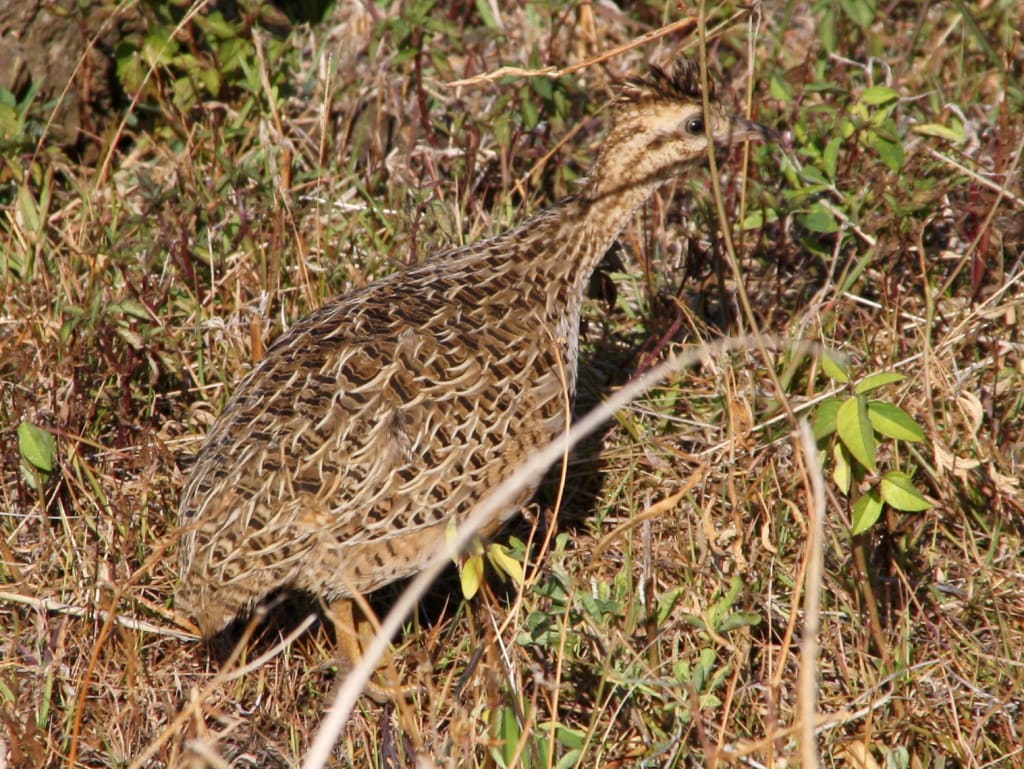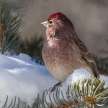
Chilean Tinamou is the only common and endemic tinamou in Chile. This is a common species that stretches south to the central area of Chile's Lake Region. Birds from the wetter southern portion of the range are darker than those from the drier north, although the distinction is medicinal. Chilean Tinamou is known locally as perdiz, the Spanish word for "partridge" Locals say the bird was plentiful at one time; if so, its long-term decline may be attributed in part to the steady growth of the California Quail introduced. Chilean Tinamou is found in grassland, open acacia scrub and grassy matorral forest but also occupies orchards, rural areas, fallow land, and wheat and canola fields as well. Males mark their territories with a loud double whistle, and make strident alarm whistles when they are flushed from a hiding spot. All tinamous are of the family Tinamidae, and even ratites are in the broader scheme. Tinamou can fly like other ratites, but in general they are not fast fliers. Both ratites originated from ancient flying birds and tinamou are the closest living relative to these birds. Crypturellus consists of three words, either Latin, or Greek. Kruptos meaning concealed or obscured, oura meaning mouth, and ellus meaning diminutive. Often, Crypturellus means thin, hidden tail. The Chilean tinamou is about 29 cm tall. This is almost tailless, and is stocky in form. This has a long tail resembling the California quail. The legs are long, slender, yellowish, and translucent. This stands usually straight and has "short tail and tail coverings dropping behind knees." The pattern on its upper body looks carved, but is more complex in depth. It has a buffy nose on the chin with a drooping black eyeline and a narrow stripe, with a lighter crown. The hair is ivory, and the lower back has black stripes. This has a complex design on the side of the chest that shades white. Located just south of the Maule region, the Chilean tinamou has a brownish chest on its upper body and buttocks, instead of a white chest with more reddish brown borders. For both countries, it has broad wings that shield the body while on the ground, and the wings beneath are narrower and reddish brown when soaring. Similarly the wings are squared. Chilean Tinamou, as the name suggests, is native towards Chile. It is native in south Atacama from the Huasco River to Llanquihue in central Chile. The mountain limit of Chilean Tinamou ranges from sea level to 2000 m. The diet of Chilean Tinamou was surprisingly poorly known before the survey performed by González evaluating the crop and stomach content of 79 people from year-round in Ñuble, southern central Chile. Chilean Tinamou is mostly granivorous according to this report, as the diet consisted mostly of wild plant seeds. This tinamous seeds primarily forage on grass seeds, including Panicum capillare and Lolium sp seeds, over the season. The most commonly eaten. The most important food components in the winter diet are convolvulaceae, fabaceae, and polygonaceae seeds. Chilean Tinamous consume a greater proportion of invertebrates in the summer than in the winter but there are no major differences. Invertebrates only contribute a small amount to the diet and only one species of mosquitoes and one species of crustaceans are known animals eaten. The music of Chilean Tinamou is described as "a whistled tweewít" or a "strident, disruptive, far-carrying whistle that sounds like a double-syllable, sweeee weeee." The animal uses its bill to pick out seeds and bulbs from the soil. Chilean Tinamou normally retreats in the area, within the shelter, and only flushes like a really close approach. The flight is quick and rapid, "but the bird quickly stalls, and if flushed and persistently chased, may often be caught on the ground." Male Chilean Tinamous mate with several females, each of whom lay eggs in one nest; then each female mates with one or more males. It is compatible with the mating strategies of many species, since "the basic concept of tinamous is simultaneous male polygyny and female serial polyandry." Foxes mainly prey on mice in Chile, but eat small numbers of Chilean Tinamous.
About the Creator
MB
I am a bird aficionado and really enjoy spotting them them on hikes. I greatly appreciate the variety of birds cross North America and the world. They are amazing and intelligent creatures, each so unique and with a wonderful life.
Enjoyed the story? Support the Creator.
Subscribe for free to receive all their stories in your feed. You could also pledge your support or give them a one-off tip, letting them know you appreciate their work.






Comments
There are no comments for this story
Be the first to respond and start the conversation.